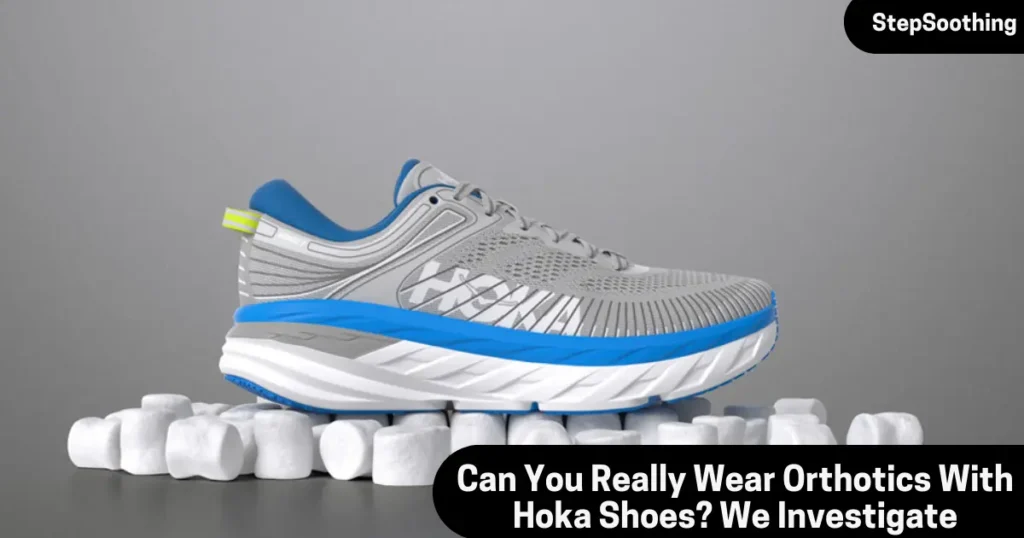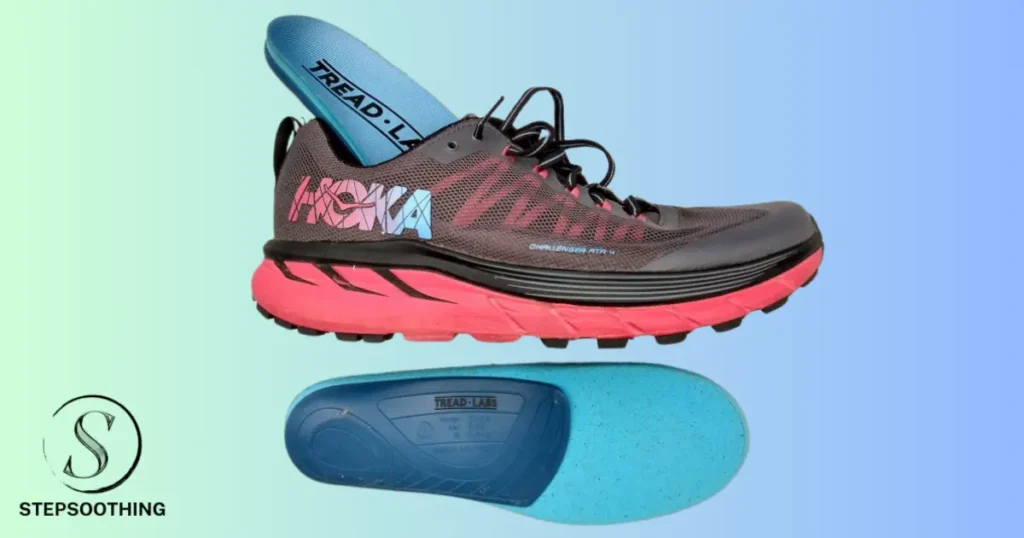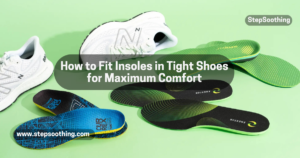Hoka shoes have become popular in recent years for their extremely thick, cushioned midsoles. This makes them ideal for runners and athletes looking for plenty of shock absorption.
If you currently wear custom or off-the-shelf orthotics, you may be wondering if you can use them together with Hoka shoes. There are a few factors to consider when it comes to fit, sizing, and functionality. This article will cover everything you need to know.
Orthotics and Hoka Shoes: Do They Really Work Together?

What are Hoka Shoes?
Hoka shoes stand out for their oversized midsoles that are much thicker than average running/athletic shoes. This provides exceptional cushioning to soften impact.
Despite the chunky sole, the overall shoe is kept lightweight thanks to the breathable mesh uppers. The designs also feature meta rocker technology to facilitate smoother transitions.
Hoka began solely as a running shoe brand but now offers lifestyle and hiking styles too.
Benefits of Orthotics
Orthotics are inserts placed inside shoes to provide control, improved alignment, and support. Custom-made orthotics require casting and fitting by a specialist. There are also off-the-shelf versions available. Reasons people may wear orthotics include:
- Relieve pain from plantar fasciitis or arthritis
- Address over/under pronation
- Support flat feet or fallen arches
- Alleviate pressure on metatarsals or bunions
- Aid recovery from injury
Having the proper orthotic support can be very beneficial for comfort and correcting biomechanical issues that contribute to pain or risk of injury.

Key Factors to Consider
There are a few key factors when determining if your particular Hoka shoes will work with orthotics:
Cushioning Level
Extra cushioned Hokas may be easier to wear with orthotics versus minimalist models. There needs to be enough depth and space to accommodate inserts.
Removable vs Fixed Insole
Hokas with removable insoles allow you to take out the factory insole and replace it with your orthotics. Fixed insoles don’t permit modifications.
Interior Height/Volume
Hoka interiors must have adequate vertical space so orthotics don’t press too tightly against your feet.
Type of Orthotic
Rigid, custom orthotics may require more accommodation compared to soft over-the-counter options.
Tips for Getting the Right Fit
If you want to wear your orthotics with Hokas, keep these tips in mind:
- Size up half a size if using very thick orthotics to allow space
- Always try shoes on with orthotics inserted to test comfort and fit
- Prioritize Hoka models with removable insoles for easy switching
- Consult your orthotics provider to bring shoes and identify good pairing options
Getting professionally fitted for shoes while wearing your orthotics is highly recommended. An expert can help select the right model and size based on your feet, orthotic dimensions, gait analysis, and intended activity.

Maximizing Comfort and Support
It may take some time adjusting to new shoes and orthotics. Here are some tips:
- Break them both in gradually to allow your body to adapt
- Monitor any foot pressure points and irritation
- Adjust lacing to accommodate insert if needed
- Use an aftermarket insole for extra cushioning if still feeling discomfort
Have a podiatrist or orthotic specialist help fine-tune and make any adjustments for optimal comfort, support, and function.
When to Take Caution
While many opt to wear orthotics with Hokas, there are some instances when caution should be exercised:
- You experience significant new foot pain wearing the orthotics. Discontinue use and seek guidance from your podiatrist.
- The Hoka feels excessively rigid or loose when inserted with the orthotic. This risks injury.
- The orthotics alter proper shoe sizing to the point where fit is compromised.
- You have a history of recurrent ankle rolling or foot/ankle instability. The extra height may increase risk.
If any of the above apply, stop wearing the Hokas with your orthotics. Get professional help adjusting fit or try a different shoe model instead.
Conclusion
Hoka shoes can often be worn together with orthotics for their plush cushioning and removable insoles. However, it’s important to select the appropriate model, get properly fitted, and take things slowly when breaking them in. Make adjustments as needed and seek guidance if significant pain or sizing issues occur. With some care taken upfront, Hokas can be a great shoe choice to accommodate your orthotics.
Additional Resources To further information on Insoles, check out How Long Do Orthotics Last, Orthotics vs Insoles: Everything You Need to Know, Dr. Scholl’s Custom Fit Number Meaning and How Long Do Shoe Inserts Last? Unlocking Insole Secrets. If you’re interested in How to use Insoles Correctly, explore our guide here.
Frequently Asked Questions
Do Hoka shoes work with orthotics?
Yes, Hoka shoes are highly compatible with orthotics and custom insoles. Their removable sockliners and wide toe boxes allow orthotics to fit comfortably. Hokas provide a stable base for the arch support of inserts.
Are Hoka shoes good for arch support?
Hoka shoes have excellent built-in arch support from their signature thick, cushioned midsoles. The curved shape also cradles the arches. However, those needing extra arch support can use supportive insoles or orthotics.
Are Hoka Clifton 8 good for orthotics?
The Hoka Clifton 8 running shoes work very well with orthotics due to the wide, deep toe box and removable insole. Testers note solid stability for the orthotic along with the signature Hoka cushioning.
Why do podiatrists recommend Hoka?
Podiatrists often recommend Hoka due to the thick cushioned midsole that absorbs shock and provides soft, supportive comfort for sore, sensitive feet. The meta-rocker sole also encourages a smooth transition through the gait cycle.
Can you put inserts in Hoka?
Yes, Hoka shoes accommodate inserts and orthotics with their removable sockliners. There is enough volume and room in the toe box for inserts without compromising Hoka’s comfort.
Which Hoka running shoes are best for orthotics?
The Clifton, Bondi, Arahi, Gaviota, and Rincon Hoka running shoe models work exceptionally well with orthotics. Their cushioning paired with orthotic support makes them ideal for runners requiring extra arch support.
Key features
Hoka shoes have become popular in recent years for their extremely thick, cushioned midsoles. This makes them ideal for runners and athletes looking for plenty of shock absorption.
If you currently wear custom or off-the-shelf orthotics, you may be wondering if you can use them together with Hoka shoes. There are a few factors to consider when it comes to fit, sizing, and functionality. This article will cover everything you need to know.
Orthotics and Hoka Shoes: Do They Really Work Together?

What are Hoka Shoes?
Hoka shoes stand out for their oversized midsoles that are much thicker than average running/athletic shoes. This provides exceptional cushioning to soften impact.
Despite the chunky sole, the overall shoe is kept lightweight thanks to the breathable mesh uppers. The designs also feature meta rocker technology to facilitate smoother transitions.
Hoka began solely as a running shoe brand but now offers lifestyle and hiking styles too.
Benefits of Orthotics
Orthotics are inserts placed inside shoes to provide control, improved alignment, and support. Custom-made orthotics require casting and fitting by a specialist. There are also off-the-shelf versions available. Reasons people may wear orthotics include:
- Relieve pain from plantar fasciitis or arthritis
- Address over/under pronation
- Support flat feet or fallen arches
- Alleviate pressure on metatarsals or bunions
- Aid recovery from injury
Having the proper orthotic support can be very beneficial for comfort and correcting biomechanical issues that contribute to pain or risk of injury.

Key Factors to Consider
There are a few key factors when determining if your particular Hoka shoes will work with orthotics:
Cushioning Level
Extra cushioned Hokas may be easier to wear with orthotics versus minimalist models. There needs to be enough depth and space to accommodate inserts.
Removable vs Fixed Insole
Hokas with removable insoles allow you to take out the factory insole and replace it with your orthotics. Fixed insoles don’t permit modifications.
Interior Height/Volume
Hoka interiors must have adequate vertical space so orthotics don’t press too tightly against your feet.
Type of Orthotic
Rigid, custom orthotics may require more accommodation compared to soft over-the-counter options.
Tips for Getting the Right Fit
If you want to wear your orthotics with Hokas, keep these tips in mind:
- Size up half a size if using very thick orthotics to allow space
- Always try shoes on with orthotics inserted to test comfort and fit
- Prioritize Hoka models with removable insoles for easy switching
- Consult your orthotics provider to bring shoes and identify good pairing options
Getting professionally fitted for shoes while wearing your orthotics is highly recommended. An expert can help select the right model and size based on your feet, orthotic dimensions, gait analysis, and intended activity.

Maximizing Comfort and Support
It may take some time adjusting to new shoes and orthotics. Here are some tips:
- Break them both in gradually to allow your body to adapt
- Monitor any foot pressure points and irritation
- Adjust lacing to accommodate insert if needed
- Use an aftermarket insole for extra cushioning if still feeling discomfort
Have a podiatrist or orthotic specialist help fine-tune and make any adjustments for optimal comfort, support, and function.
When to Take Caution
While many opt to wear orthotics with Hokas, there are some instances when caution should be exercised:
- You experience significant new foot pain wearing the orthotics. Discontinue use and seek guidance from your podiatrist.
- The Hoka feels excessively rigid or loose when inserted with the orthotic. This risks injury.
- The orthotics alter proper shoe sizing to the point where fit is compromised.
- You have a history of recurrent ankle rolling or foot/ankle instability. The extra height may increase risk.
If any of the above apply, stop wearing the Hokas with your orthotics. Get professional help adjusting fit or try a different shoe model instead.
Conclusion
Hoka shoes can often be worn together with orthotics for their plush cushioning and removable insoles. However, it’s important to select the appropriate model, get properly fitted, and take things slowly when breaking them in. Make adjustments as needed and seek guidance if significant pain or sizing issues occur. With some care taken upfront, Hokas can be a great shoe choice to accommodate your orthotics.
Additional Resources To further information on Insoles, check out How Long Do Orthotics Last, Orthotics vs Insoles: Everything You Need to Know, Dr. Scholl’s Custom Fit Number Meaning and How Long Do Shoe Inserts Last? Unlocking Insole Secrets. If you’re interested in How to use Insoles Correctly, explore our guide here.
Frequently Asked Questions
Do Hoka shoes work with orthotics?
Yes, Hoka shoes are highly compatible with orthotics and custom insoles. Their removable sockliners and wide toe boxes allow orthotics to fit comfortably. Hokas provide a stable base for the arch support of inserts.
Are Hoka shoes good for arch support?
Hoka shoes have excellent built-in arch support from their signature thick, cushioned midsoles. The curved shape also cradles the arches. However, those needing extra arch support can use supportive insoles or orthotics.
Are Hoka Clifton 8 good for orthotics?
The Hoka Clifton 8 running shoes work very well with orthotics due to the wide, deep toe box and removable insole. Testers note solid stability for the orthotic along with the signature Hoka cushioning.
Why do podiatrists recommend Hoka?
Podiatrists often recommend Hoka due to the thick cushioned midsole that absorbs shock and provides soft, supportive comfort for sore, sensitive feet. The meta-rocker sole also encourages a smooth transition through the gait cycle.
Can you put inserts in Hoka?
Yes, Hoka shoes accommodate inserts and orthotics with their removable sockliners. There is enough volume and room in the toe box for inserts without compromising Hoka’s comfort.
Which Hoka running shoes are best for orthotics?
The Clifton, Bondi, Arahi, Gaviota, and Rincon Hoka running shoe models work exceptionally well with orthotics. Their cushioning paired with orthotic support makes them ideal for runners requiring extra arch support.
Key Updates:
Hoka shoes remain a popular choice for athletes due to their thick cushioning and shock absorption. While they offer excellent comfort, compatibility with orthotics requires attention to a few factors, especially with the newer Hoka models.
- Cushioning and Support: Hoka continues to emphasize cushioning in newer models like the Gaviota 5, which has seen updates in midsole design for better comfort and stability, especially for those using orthotics.
- Orthotic Compatibility: Shoes like the Hoka Clifton 8 and Gaviota 5 are designed to accommodate orthotics thanks to removable insoles and roomy toe boxes, ensuring a good fit for custom orthotics.
- The Bondi and Arahi models are also noted for their orthotic-friendly design, offering deep, cushioned midsoles and wide spaces for inserts.
- Meta-Rocker Technology: Hoka’s Meta-Rocker technology, present in many models, promotes smoother transitions, which may further benefit individuals using orthotics by enhancing walking or running mechanics.
- Caution with Sizing and Fit: For individuals using thick orthotics, sizing up is recommended. Moreover, checking the fit with orthotics in place before purchase is crucial to avoid discomfort.
Hoka shoes continue to work well with orthotics, especially in models with removable insoles like the Clifton 8, Bondi, and Gaviota 5. Ensuring a proper fit is essential, and it’s always a good idea to consult with a professional before choosing a model, especially if you have specific foot concerns or require custom orthotics.



